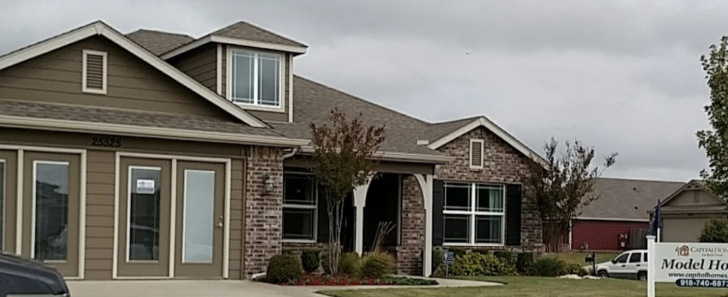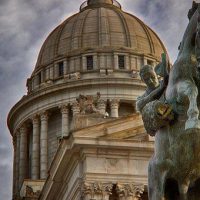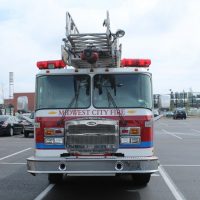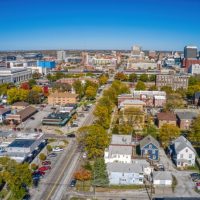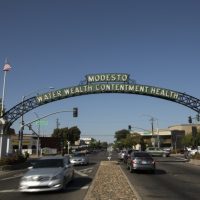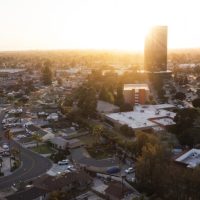Broken Arrow, Oklahoma is in the greater Tulsa metropolitan area, and both Tulsa and Broken Arrow are rated among the best places to live in Oklahoma, and even the United States.
There is a low cost of living, and there is somewhat of a comfortable small-town vibe even though it is a good-sized city with all the city amenities you could want.
There is a lot to recommend Broken Arrow, and there are few negatives to contend with.
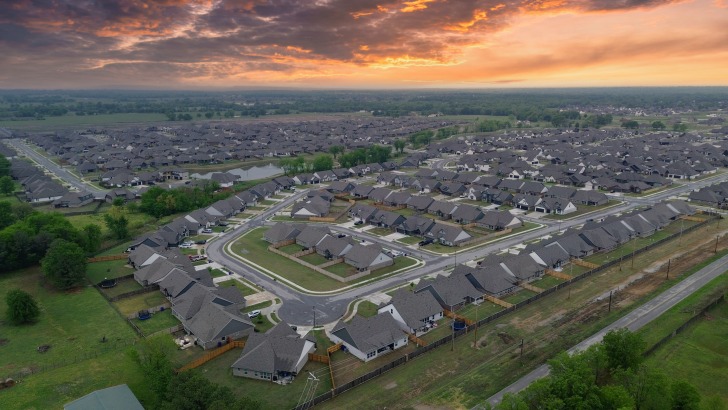
Contents
- Pros of Living in Broken Arrow, OK
- Cons of Living in Broken Arrow
- Pros and Cons of Living in Broken Arrow, OK – Summary Table
- Broken Arrow Safety Overview
- Frequently Asked Questions
- What does the term Broken Arrow mean to Native Americans?
- How did Broken Arrow become a city?
- What is the advantage of a sales tax over other taxes?
- What is the sales tax in Broken Arrow?
- What is the tax burden in Broken Arrow?
- Why is downtown Broken Arrow called the Rose District?
- What is meant by the term daughter city?
Pros of Living in Broken Arrow, OK
1. High Quality of Life
Broken Arrow has all the things you want in a city, and many of the things you don’t want are not there either.
The cost of living is low, there is little crime, schools are good, and housing is affordable.
Being next to Tulsa makes a big city close enough to enjoy its amenities as well.
Money Magazine included it in its top 100 places to live in America.
2. Low Crime Rate
The crime rate in Broken Arrow is low, and that may be surprising considering it is part of the larger Tulsa Metropolitan area.
There are 1.52 violent crimes per 1,000 people, less than half the national average of 4.0, and lower than the state average of 4.4.
Property crimes are a little more common, at 18.33 per 1,000, which is very close to the national average of 19.
The state average is 26.
There is some crime everywhere, but Broken Arrow is a safe place to live.
3. Low Cost of Living
Oklahoma is one of the cheapest states to live in America.
Broken Arrow is slightly higher than the state average, but still below the national average.
The cost of living is two percent higher than the state average and 11 percent below the national average.
The cost of living is lower than the national average in every metric.
Food, utilities, rent, transportation, health care, and many other items are far below the national average.
4. Housing Costs
If you compare housing costs to neighboring Tulsa, the prices seem high, but they are still far below the national average.
A typical house in Broken Arrow sells for $247,000, while the same house in Tulsa will go for $180,000.
The average home price in the United States is $416,000.
Some areas are more expensive than others, but the overall hosting cost in Broken Arrow is still low compared to the national average.
A large percentage of people in Broken Arrow own their homes.
5. Solid Schools
Schools are generally well thought of in the Tulsa area.
The percentage of students proficient in reading (28%) and math (24%) is fairly low compared to a lot of schools.
Even so, SAT and ACT scores, which help kids get into college, are within the national averages.
There is an 18-1 student-teacher ratio, which is good for city public schools.
The school district has 19,000 students, with two high schools.
The district spends $10,338 per student, with the national average at $12,239.
6. The Tulsa Area
The Tulsa metropolitan area has just over one million people, making it a large city.
Broken Arrow has about 100,000 people.
There are lots of parks and lots of activities to enjoy.
Tulsa and Broken Arrow both have vibrant art scenes usually found only in much larger cities.
Broken Arrow and Tulsa share a border that is long, so it may be hard to tell which city you are in most of the time.
7. Native American Culture
Oklahoma was Indian Land, and there are still many Indian Nations represented in the area.
Native American art is everywhere, and cultural influences can be seen in many areas.
Cherokee and Creek nations were the first Indians to be resettled in this area and in Oklahoma.
The name Broken Arrow itself has a significant meaning to Native American peoples.
8. Strong Economy
The cost of living is six percent below the national average, and the average income of $74,000 is 10 percent higher than the national average.
Unemployment is at three percent, and the poverty rate is 8.4 percent, both of which are well below national averages.
The low poverty rate, and low unemployment, are good indications of the strength of the local economy.
9. The Outdoors
State parks, and wilderness areas, are very close to Broken Arrow and easily accessible.
You can enjoy any kind of outdoor activity all year long.
The scenery in this area is very green, and includes a lot of hills and small mountains, making it the most scenic area of the state.
Cons of Living in Broken Arrow
1. Can Be Crowded
Broken Arrow has a lot of people in a relatively small area.
There are 1,800 people per square mile.
Oklahoma City has 1123 for comparison purposes.
It’s still well below places like New York City which has 28,000.
The average for all cities is 283.
There are cultural advantages to urban density, but there is also environmental and general stress on people because of crowding.
2. Infrastructure Issues
Oklahoma has lower taxes in general, but this results in repairs not being made to things like highways.
Roads in the city, as well as the entire state, need modernizing.
Public transportation also needs to be improved.
The water and sewer systems are also aging, though they are working fine at present.
3. Conservative Area
This may or may not be a con, depending on your politics.
It is, however, a very conservative area, so that might enter into any decision you make about moving there.
Oklahoma itself is conservative, and the general Tulsa area is not an exception to that idea.
This mostly means you will run into a lot of conservative people who have conservative ideas.
4. Too Close to Tulsa
Being in the greater Tulsa metropolitan area is a plus, but being right next to Tulsa has its disadvantages as well.
Broken Arrow will always be considered the little brother of Tulsa.
They share a border, so you may not know which city you are in.
Tulsa also has more of the negative big city issues like crime, and that spills over into Broken Arrow.
5. Weather
It does not get terribly cold in winter, but summers can be very hot.
Temperatures may get to 100 in summer, and humidity makes that even worse.
You will need air conditioning in Broken Arrow to be comfortable.
There are the rare ice storms in winter, that wreak havoc because no one is used to it or prepared.
6. Violent Storms
Oklahoma is known for its tornadoes.
The central part of the state has a lot of them, and this eastern area is not spared.
Tornadoes can rise up out of nowhere, so you have to be mindful if there are any storms in the area at all.
There are also violent thunderstorms and even hailstorms in summer.
Not many people are killed in tornadoes, but you still have to be on guard.
7. Fast Growth
As recently as 1970, Broken Arrow had just 12,000 people.
It grew by more than 100 percent in each of the next two decades.
Growth has continued rapidly, so much so that the 15 percent growth in 2020, was the lowest in nearly 100 years.
Fast growth can be good for the economy, but the infrastructure usually suffers as a result.
It is hard for any city to keep up with rapid growth.
It may not be growing as fast as it was, but it is still growing.
8. Income Disparity
The oil boom in the early 1900s made some people very wealthy in Oklahoma, but not everyone benefited.
The poverty level is fairly low, but there are also a lot of people working low-paying jobs.
The cost of living remains low, which helps, but there remains a class of “haves” and “have not” in Oklahoma and in Broken Arrow.
9. Insects
Anywhere that has hot weather in the south is going to have a lot of bugs.
There are a lot of mosquitos in summer, as well as other nuisance insects like ants or flies.
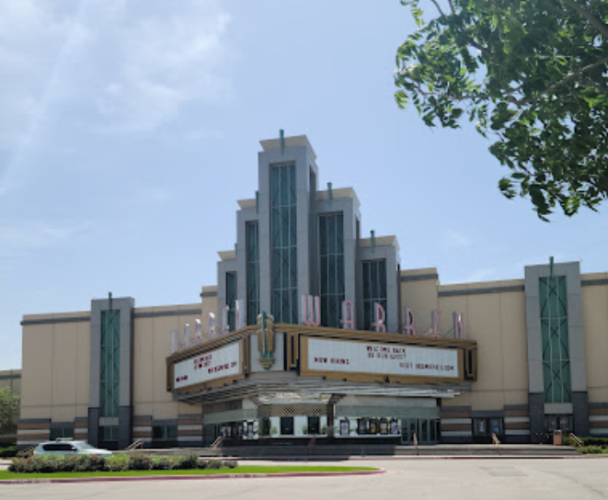
Pros and Cons of Living in Broken Arrow, OK – Summary Table
| Pros of Living in Broken Arrow, OK | Cons of Living in Broken Arrow |
|---|---|
| 1. High Quality of Life | 1. Can Be Crowded |
| 2. Low Crime Rate | 2. Infrastructure Issues |
| 3. Low Cost of Living | 3. Conservative Area |
| 4. Housing Costs | 4. Too Close to Tulsa |
| 5. Solid Schools | 5. Weather |
| 6. The Tulsa Area | 6. Violent Storms |
| 7. Native American Culture | 7. Fast Growth |
| 8. Strong Economy | 8. Income Disparity |
| 9. The Outdoors | 9. Insects |
Broken Arrow Safety Overview
READ THE FULL REPORT: Broken Arrow Safety Review
Safety Index:
- OVERALL RISK: LOW
- TRANSPORT & TAXIS RISK: LOW
- PICKPOCKETS RISK: LOW
- NATURAL DISASTERS RISK: MEDIUM
- MUGGING RISK: LOW
- TERRORISM RISK: LOW
- SCAMS RISK: LOW
- WOMEN TRAVELERS RISK: LOW
Frequently Asked Questions
What does the term Broken Arrow mean to Native Americans?
A broken arrow is a symbol of peace to many Native Americans.
It shows that the war, or conflict, has ended and that weapons of war are no longer needed.
Two crossed arrows represent friendship.
How did Broken Arrow become a city?
Native Americans, who were moved here from Alabama in the early 1800s settled here and gave it that name.
It was not a formal city until the railroads were developed and a townsite was planned.
When the railroad named the town, and it became an official city, it adopted the name local people were using, which was Broken Arrow.
What is the advantage of a sales tax over other taxes?
Property taxes affect only property owners, and income tax only affects the individual.
Sales tax is a tax on everyone.
Broken Arrow has a significant amount of tourism, so a sales tax will collect revenue from people who do not live there, at least in theory.
What is the sales tax in Broken Arrow?
The state sales tax is 4.5 percent.
Local governments, such as cities, schools, and counties, can also levy sales taxes to collect revenue.
Broken Arrow is at 9.34 percent.
Cities around the state range from eight to 11 percent.
The City of Tulsa is at 8.9 percent.
What is the tax burden in Broken Arrow?
Oklahoma ranks 41st out of 50 states as far as how much taxes people have to pay.
The average tax liability, including all taxes, is $2,359 annually.
Property taxes are generally low around the state, and while Broken Arrow is above the state average it remains well below the national average.
Why is downtown Broken Arrow called the Rose District?
When the city was young, leaders wanted to improve the appearance of the town and encouraged planting.
Many people chose to plant rose bushes, and roses became very common in the downtown area.
It was called the City of Roses.
The downtown was refurbished and became known as the Rose District.
What is meant by the term daughter city?
When Native Americans were forcibly removed from their homes in the east, they recreated the town they had from where they had moved from.
One such down was Coweta.
When Coweta got too large, a group moved 20 miles away and started a new settlement that became Broken Arrow.
A daughter city is one that was developed from another city.
